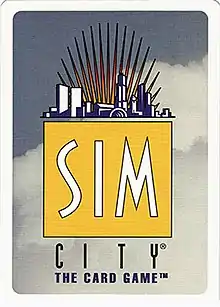Sim City: The Card Game
Sim City: The Card Game is an out-of-print collectible card game based on the video game SimCity by Maxis. The goal of the game is to build a city from the ground up. Players take turns playing cards representing city blocks and collect profit.[1]
 Card back of SimCity the Card Game | |
| Origin | SimCity |
|---|---|
| Type | Collectible card game |
| Players | 1+ |
| Age range | 10 and up |
| Chance | Medium |
| Related games | |
| SimCity series, Sim series | |
Publication history
The original game was released in 1995 by Mayfair Games and contained 517 cards (363 standard size, 154 long) sold in 60-card starter decks and 15-card booster packs.[2][3]: 4 The starter decks consisted of 5 rare cards, 19 uncommon cards, and 36 common cards, and booster packs consisted of 1 ultra-rare card, 1 rare card, 5 uncommon cards, and 8 common cards.[2] Boxes contained 12 starter decks or 32 booster packs.[2] The long cards are almost twice the width of standard cards and are all ultra-rare.[4]
Several city fixed-deck expansion sets followed, adding location and politician cards from various cities, including Chicago, Washington (March 1996[5]: 19 ), New York City (May 1996[6]), and Atlanta.[7] Several expansions were planned but never released including Hollywood, Paris, Toronto and Denver.[7] Eleven different promo packs were also released with 10 fixed cards each. Some of these promo packs included the promos that appeared as magazine inserts.[7] Another source noted over 150 promo cards, some released to conventions and gaming stores.[8] One promo was only available from Combo magazine and featured a picture of the Combo offices.[9]
Darwin Bromley, the president and founder of Mayfair Games at the time, appeared as a "Mayor" card in the game.[10] Bromley was also the conceptual designer behind the game.[11][12]
Gameplay
The object of the game is to build a municipality through four phases: settlement, town, city, and metropolis.[4] The game progresses as both a cooperative game and a competitive game.[2] Each card has a value and a zone associated with it, the latter indicated by the color on the title box.[2] The seven zones are Agricultural, City Services, Commercial, Government, Industrial, Residential, and Special.[2]
In the settlement phase, the majority of cards played will consist of undeveloped land and residential zone cards.[4] The town phase increases the number of playable zones, and the city phase allows all zones.[4] The metropolis phase is the only one to permit the special long cards.[4]
The first player to play a power plant at the end of the second phase becomes mayor and automatically receives a tie-breaking vote for the city council.[2] Other players may become city councillors by playing a city council member card in the third or fourth phases of the game.[2] The city council accepts or declines rezoning requests from any players.[2] Any played card may be upgraded by playing another card of higher value from the same zoning group atop it, or may be rezoned for special long cards.[2]
A player earns bucks, the point system of the game, as indicated on each card played, and may earn bonus points based on its placement and surrounding cards.[2] Laying cards next to others of the same zone earns a number of bonus points equal to the number of neighboring cards of the same zone.[2] A complex bonus may also be awarded based on the specific type of location instead of a zone.[2] Some cards award a negative bonus, such as a landfill adjacent to a residential zone.[2] A disaster card may disrupt some part of the game, some necessitating the mayor to pay bucks to protect the city.[4] The first player to earn 250 bucks wins the game.[4]
Reception
Rick Swan reviewed Sim City: The Card Game for Dragon magazine #221 (September 1995).[13] Swan says that "While the card game doesn't scale the heights of the computer game, it comes close."[13] Swan concluded his review by saying "Sim City looks like a winner."[13] The game was based on a solitaire computer game and was noted as one of the "lowest-conflict" collectible card games at that time. The aim of each player is to add to their own city and the only "attack" cards were natural disasters.[7]
References
- Brown, Timothy (1999), The Official Price Guide to Collectible Card Games, pp. 372–382.
- "Sim City: The Card Game". Scrye. No. 6. April–May 1995. pp. 98–99.
- "Product news". InQuest. Wizard Entertainment. 1995. pp. 4–8.
- Price, Faith (February 1995). "Sim City: The Card Game". Scrye. No. 4. p. 64.
- Varney, Allen (February 1996). "Reports on trading card games". The Duelist. Vol. 3, no. 1. pp. 19–21.
- Forbeck, Matt (June 1996). "On the shelves". InQuest. No. 14. Wizard Entertainment. p. 22.
- Miller, John Jackson (2003), Scrye Collectible Card Game Checklist & Price Guide, Second Edition, pp. 516–521.
- Necroscourge (25 February 2013). "Tabletop Tales: 'SimCity: The Card Game'". Geekscape.net. Retrieved 2019-01-07.
- Owens, Thomas S.; Helmer, Diana Star (1996), Inside Collectible Card Games, p. 84.
- Owens, Thomas S.; Helmer, Diana Star (1996), Inside Collectible Card Games, p. 53.
- Writer, Stephen Lee, Tribune Staff (April 1996). "TALES OF A CITY FOUND IN THE CARDS". chicagotribune.com.
{{cite web}}: CS1 maint: multiple names: authors list (link) - "Darwin Paul Bromley : Obituary". The Florida Times-Union. Retrieved 7 January 2019.
- Swan, Rick (September 1995). "Role-playing Reviews". Dragon. Lake Geneva, Wisconsin: TSR (#221): 46.
- "Pyramid: Pyramid Pick: Sim City: The Card Game".
Further reading
- Price, Faith (Fall 1994). "Sim City: The Card Game". The Duelist. No. 3. Wizards of the Coast. p. 48.
- Varney, Allen (1995). "On the town with Sim City: The Card Game". The Duelist. No. 6. Wizards of the Coast. pp. 100–101.
- "Sim City: The Card Game rule book". Scrye. No. 7. May–June 1995. pp. 115–118.